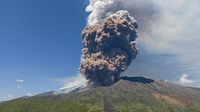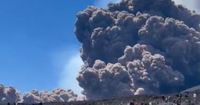Mount Etna, Europe’s most active volcano, erupted dramatically on Monday, June 2, 2025, sending towering plumes of ash and smoke high into the Sicilian sky and sparking a chaotic scene as tourists fled for their lives. The eruption, which unfolded over several hours, was marked by intense strombolian explosions and a powerful pyroclastic flow cascading down the mountain’s slopes, though fortunately, no injuries have been reported.
According to Italy’s National Institute of Geophysics and Volcanology (INGV) at the Etna Observatory in Catania, the volcanic activity began in the pre-dawn hours and escalated into nearly continuous explosions of growing intensity. The first volcanic tremors were detected just after 10 PM on Sunday, June 1, localized about 2.8 kilometers beneath the crater. These tremors peaked around 1 AM, setting the stage for the violent eruption that followed.
The INGV explained that the eruption was likely triggered by a partial collapse on the northern flank of the Southeast Crater, producing a pyroclastic flow — a fast-moving avalanche of hot gas, ash, and volcanic rock. This pyroclastic material raced down the mountain but did not extend beyond the rim of the Valle del Leone, a depression on Etna’s slope. Officials emphasized that the flow was confined to this area, preventing further spread of the hazardous material.
As the eruption intensified, the explosive activity at the Southeast Crater transitioned into a sustained lava fountain, with volcanic tremor levels rising sharply. The Volcanic Ash Advisory Centre in Toulouse initially issued a red aviation warning due to the ash plume, which reached an altitude of approximately 6,400 meters, but this was soon downgraded to an orange alert. The ash cloud, composed mainly of water vapor and sulfur dioxide, drifted southwest, visible not only across Sicily but also from as far as Malta.
The eruption sent huge clouds of ash more than a mile high into the sky, dominating the skyline and casting a shadow that even began to blot out the sun in some areas. Residents in nearby towns and cities witnessed ash settling on buildings and roads, a stark reminder of Etna’s power. Despite this, Catania’s Vincenzo Bellini International Airport remained operational, with no disruptions to air traffic reported, though the aviation alert level was raised to orange to signal heightened volcanic activity.
Tourists on guided tours and independent visitors found themselves caught in the eruption’s sudden fury. Videos circulating on social media show holidaymakers scrambling along narrow ledges of the volcano, racing to escape the advancing ash cloud and pyroclastic flows. While many fled in panic, some seismologists and visitors paused to capture the awe-inspiring, if terrifying, spectacle of the monstrous ash cloud billowing behind them.
Mount Etna stands at over 3,300 meters (around 11,000 feet) and is situated atop the convergent plate margin where the African Plate meets the Eurasian Plate. This geological positioning has made it one of the most active volcanoes worldwide, with a documented history of eruptions dating back to 425 B.C. The volcano has been particularly active in recent years, experiencing 13 eruptions already in 2025. Its last eruption in May saw lava flows, and earlier this year in February, Etna sent hot lava down its slopes while skiers were nearby.
Monday’s eruption follows a pattern of persistent activity that has challenged local infrastructure and communities. Last summer, Etna’s ash clouds forced nearby airports to limit flights and divert traffic, with Catania airport reducing arriving flights to six per hour and closing a section of the facility. Local towns were blanketed in black ash, disrupting daily life.
Historical records remind us of Etna’s destructive potential. In 1669, a prolonged eruption covered 14 villages and towns with lava and triggered earthquakes, resulting in nearly 20,000 deaths and leaving thousands homeless. While Monday’s eruption was intense, the current activity has been confined to the summit area, and emergency services continue to monitor the situation closely.
The INGV’s latest updates note that ashfall has been reported in areas such as Piano Vetore, and volcanic tremors remain at very high levels. However, by early afternoon, the eruption’s intensity appeared to have calmed somewhat, though the threatening grey ash cloud remained visible over the mountain.
Mount Etna’s eruption serves as a vivid reminder of the raw power of nature and the ongoing risks faced by those living in its shadow. The volcano’s restless activity continues to captivate scientists and spectators alike, as they watch and wait to see what the next chapter in Etna’s long history will bring.


